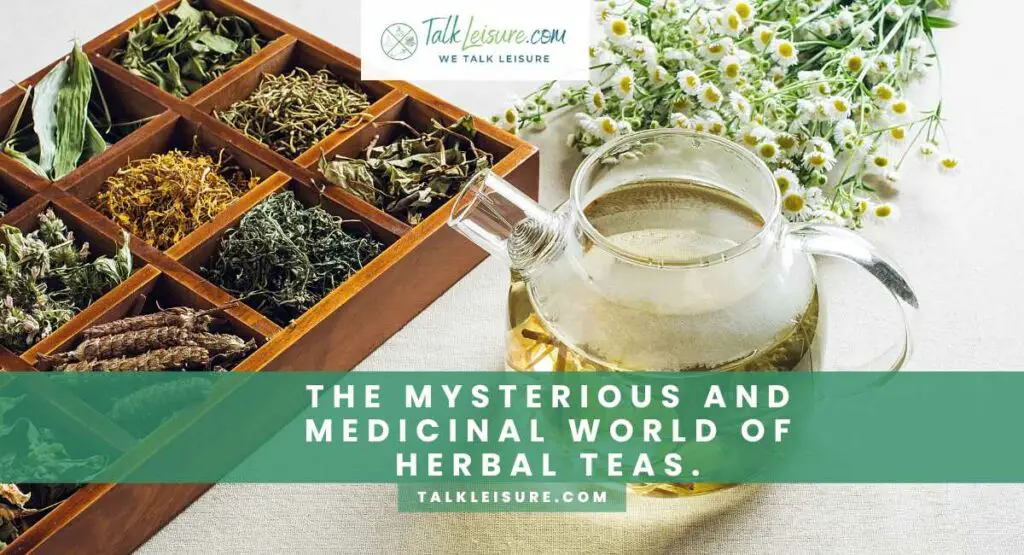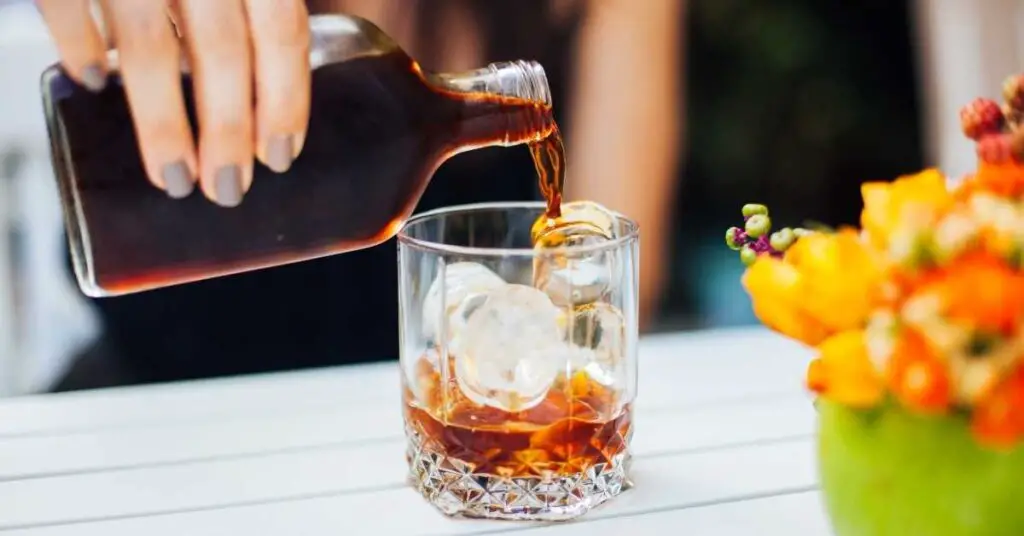Embark on a delectable journey through the enchanting world of tea-infused desserts and pastries. This culinary adventure invites you to explore the art of blending fragrant teas with sweet creations, creating a harmonious symphony of flavors.
From the soothing notes of chamomile to the robust richness of matcha, each infusion offers a unique palette for culinary creativity. Join us as we delve into essential techniques, discover health benefits, and present a tantalizing array of recipes, both traditional and globally inspired.
Whether you’re a tea aficionado or a dessert enthusiast, this guide promises a delightful fusion of two beloved worlds, redefining the boundaries of sweet indulgence.
Also read: How to pair teas with different foods for a sublime experience.
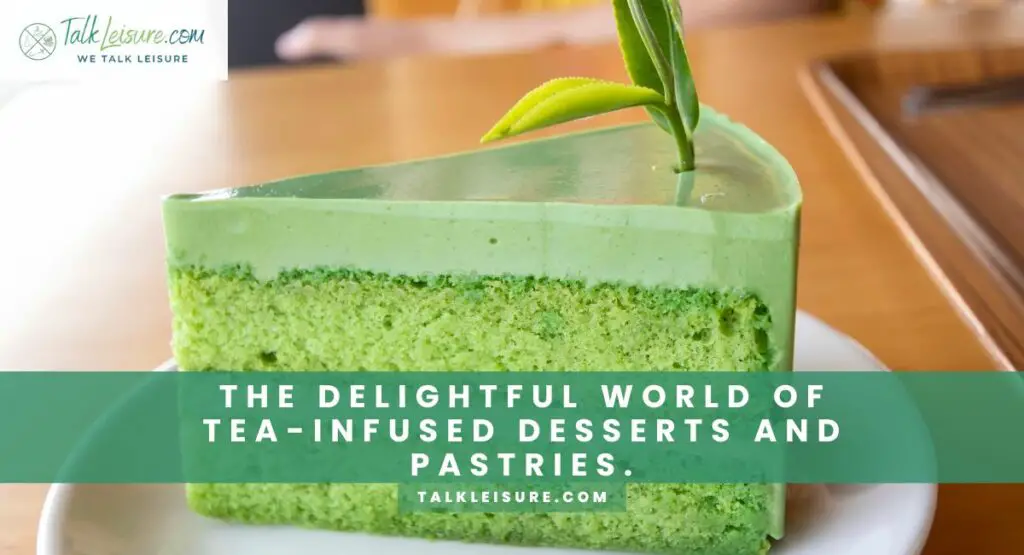
Introduction to Tea-Infused Desserts
Hey there, fellow dessert enthusiast! Today, we’re about to embark on a tantalizing journey through the delightful world of tea-infused desserts and pastries.
Imagine the harmonious blend of your favorite teas and the sweet, indulgent notes of your go-to treats. It’s a match made in culinary heaven!
Tea-infused desserts aren’t just a trend; they’re a time-honored tradition that dates back centuries.
Think about it: the gentle infusion of teas, each carrying its own unique flavor profile and aromatic bouquet, can transform ordinary desserts into extraordinary, flavor-packed creations.
Picture yourself savoring a velvety Earl Grey Crème Brûlée, where the subtle bergamot notes dance on your palate.
Or perhaps you’re indulging in a Matcha-infused Panna Cotta, its vibrant green hue hinting at the earthy undertones and grassy freshness within.
But before we dive into these delectable recipes, we’ll need to lay some groundwork. You see, not all teas are created equal when it comes to infusing desserts.
Some are bold and robust, while others are delicate and floral. We’ll unravel the mysteries of tea selection, ensuring you pick the perfect brew to complement your sweet creations.
And that’s just the beginning. We’ll be arming you with essential techniques and tools, elevating your tea-infusion game to a whole new level. From brewing methods that coax out the maximum flavor from those tea leaves to tips on achieving the perfect balance of flavors, we’ve got you covered.
So, my fellow culinary adventurer, fasten your aprons and get ready to embark on a flavorful journey. By the end of this exploration, you’ll not only have a newfound appreciation for the art of tea-infused desserts but also the skills to craft your own mouthwatering masterpieces. Get ready to tantalize those taste buds!
Also read: The mesmerizing process of hand-rolling artisanal tea leaves.
Choosing the Right Tea for Infusions
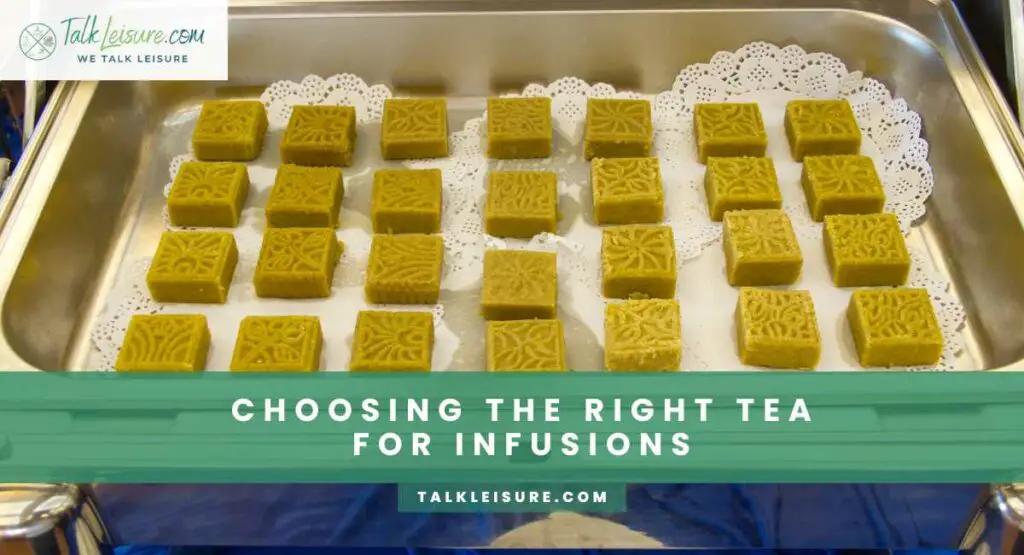
Tea selection is the cornerstone of creating exquisite tea-infused desserts. Each variety of tea brings its own distinct personality to the table, and understanding these nuances is essential.
In this section, we’ll dive into the fascinating world of teas and how their unique flavor profiles can elevate your desserts to new heights.
Types of Teas and Their Flavor Profiles
Let’s embark on a journey through the tea gardens of the world, shall we? From the mist-covered hills of Darjeeling to the lush fields of Japan, teas come in a breathtaking array of varieties. Here’s a glimpse into some of the most beloved types and what they bring to the culinary canvas:
Black Tea
- Flavor Profile: Robust, Bold, Malty
- Noteworthy Varieties: Assam, Ceylon, Keemun
- Pairings: Dark chocolate, caramel, spices
Green Tea
- Flavor Profile: Fresh, Grassy, Delicate
- Noteworthy Varieties: Sencha, Matcha, Dragon Well
- Pairings: Citrus, berries, jasmine
Oolong Tea
- Flavor Profile: Semi-Oxidized, Complex, Floral
- Noteworthy Varieties: Tie Guan Yin, Formosa, Dan Cong
- Pairings: Stone fruits, nuts, honey
White Tea
- Flavor Profile: Delicate, Subtle, Floral
- Noteworthy Varieties: Silver Needle, Bai Mu Dan, Shou Mei
- Pairings: Pear, peach, vanilla
Herbal Infusions
- Flavor Profile: Varied (depends on herbs and botanicals used)
- Noteworthy Varieties: Chamomile, Peppermint, Hibiscus
- Pairings: Citrus, ginger, berries
Remember, the key is balance. The intensity of the tea should complement, not overpower, the dessert. Experimentation is encouraged, so don’t hesitate to play with different teas and flavor combinations. You might just stumble upon a truly extraordinary pairing!
Pairing Teas with Complementary Ingredients
Tea isn’t meant to stand alone in this culinary adventure; it craves a dance partner. Pairing teas with complementary ingredients is where the real magic happens. It’s all about finding flavors that harmonize and elevate each other. Here are some classic combinations to spark your creativity:
- Earl Grey + Citrus: The bergamot in Earl Grey sings in harmony with lemon or orange zest, creating a zesty symphony.
- Jasmine Green Tea + Jasmine Blossoms: Double up on the floral notes for a fragrant infusion that transports you to a blossoming garden.
- Chai + Spices: Warm, aromatic spices like cinnamon, cardamom, and ginger complement the boldness of chai, creating a comforting, soul-soothing blend.
- Matcha + White Chocolate: The creaminess of white chocolate provides the perfect canvas for the vibrant, earthy notes of matcha to shine.
As you experiment, trust your palate. The best pairings often come from intuition and a bit of adventurous spirit. So, go ahead, mix, match, and let your taste buds be your guide!
With this understanding of tea types and their potential pairings, you’re well on your way to creating tea-infused desserts that will leave your guests in awe. So, grab your favorite teas and let’s start infusing some magic into those sweet creations!
Also read: How to care for and maintain your precious tea sets.
Essential Tools and Techniques
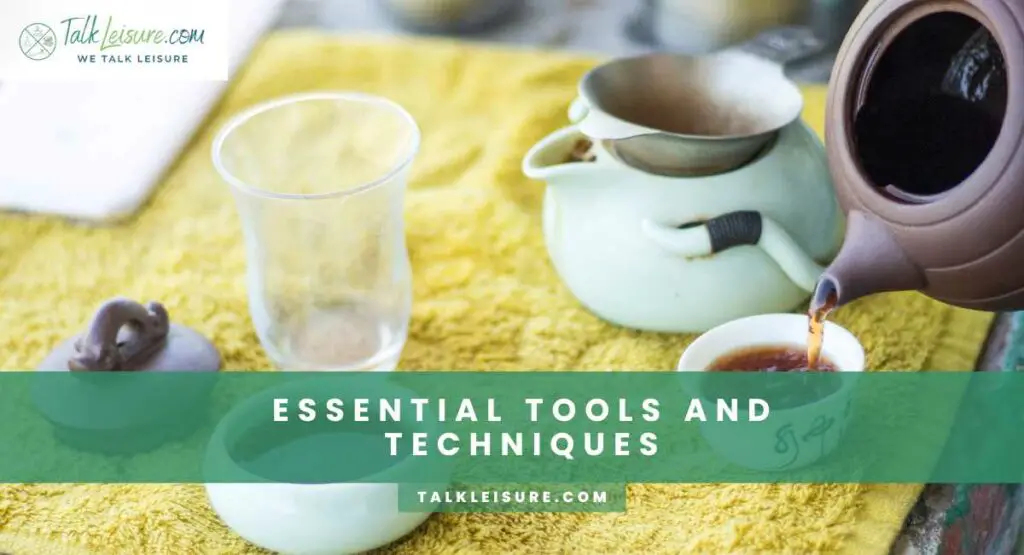
Now that we’ve delved into the art of selecting the perfect tea, it’s time to equip ourselves with the essential tools and techniques that will bring our tea-infused desserts to life. From brewing methods that coax out the full depth of flavor to extracting every last drop of essence from those precious tea leaves, this section is your key to unlocking the true potential of tea-infused delights.
Brewing Methods for Tea Infusions
Brewing tea for desserts is a delicate dance, where time and temperature play pivotal roles. Let’s explore some tried-and-true methods to ensure your chosen tea imparts its full spectrum of flavors:
1. Hot Infusion:
- Technique: Steeping tea leaves in hot water just below boiling point.
- Best for: Black teas, Oolong teas, Herbal infusions.
- Pro Tip: Use a tea infuser or a mesh ball for easy removal of leaves.
2. Cold Infusion:
- Technique: Allowing tea leaves too steep in cold water over an extended period (usually several hours).
- Best for: Green teas, White teas, Floral infusions.
- Pro Tip: Cold infusions result in a milder, smoother flavor profile.
3. Double Infusion:
- Technique: Brewing tea leaves twice to extract different flavor profiles.
- Best for: Oolong teas, certain Black teas.
- Pro Tip: The first infusion might bring out floral notes, while the second might reveal deeper, more robust flavors.
4. Simmered Infusion:
- Technique: Bringing tea leaves to a gentle simmer in a liquid (like milk or cream).
- Best for: Chai teas, Spice-infused blends
- Pro Tip: This method allows for a rich, creamy infusion ideal for custards and creams.
Extracting Maximum Flavor from Tea Leaves
Tea leaves are a treasure trove of flavor, and extracting every bit of that essence is key to creating truly exceptional tea-infused desserts. Here are some techniques to ensure you get the most out of your chosen brew:
1. Time and Temperature Control:
- Tip: Different teas have different ideal brewing times and temperatures. Follow the recommended guidelines to avoid bitterness or under-extraction.
2. Quality of Tea Leaves:
- Tip: Opt for high-qualloose-leaf teas. They have more complex flavor profiles and infuse more evenly than pre-packaged tea bags.
3. Agitation and Steeping Style:
- Tip: Gently agitate the tea leaves during steeping to encourage even extraction. For tightly rolled teas, consider a quick rinse before steeping to unfurl the leaves.
4. Multiple Infusions:
- Tip: Don’t discard those leaves after the first infusion! Many teas can be steeped multiple times, each revealing different facets of their flavor.
5. Tea-to-Liquid Ratio:
- Tip: Adjust the amount of tea leaves based on the volume of liquid to achieve the desired flavor intensity.
Armed with these techniques, you’ll be able to coax out the full potential of your chosen tea, ensuring it imparts its distinct personality to your desserts.
Remember, practice makes perfect, so don’t be afraid to experiment and fine-tune your brewing methods!
With these tools and techniques at your disposal, you’re well-equipped to infuse your desserts with the rich, nuanced flavors of tea. Now, let’s roll up our sleeves and start brewing up some culinary magic!
Tantalizing Tea-Infused Desserts and Pastries: Must-Try Recipes
Tea-Infused Custards and Creams
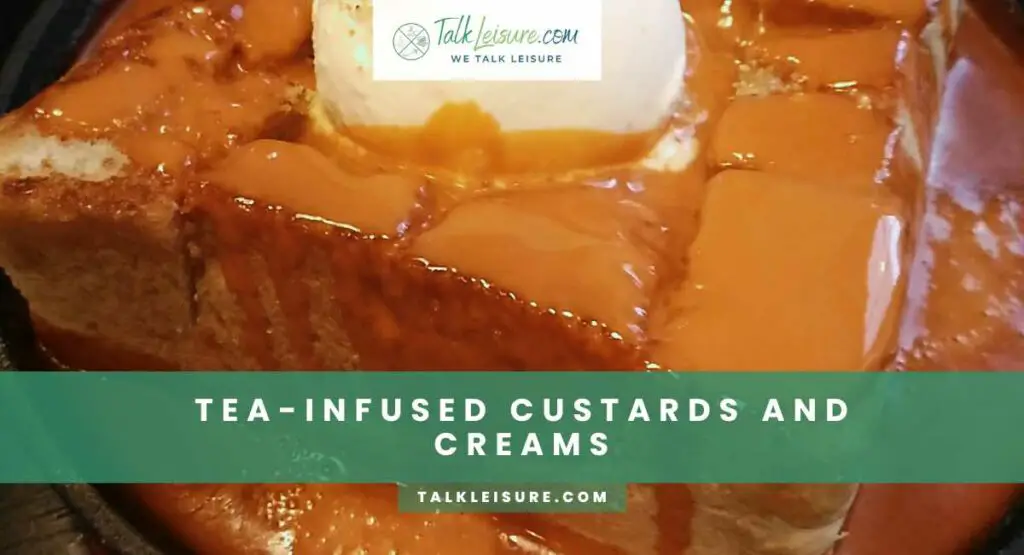
Delve into the creamy world of tea-infused custards and creams. These recipes are sure to captivate your taste buds with a delightful marriage of tea’s aromatic notes and the velvety richness of custards and creams.
Earl Grey Crème Brûlée: A Classic with a Twist
The timeless allure of Crème Brûlée meets the sophisticated charm of Earl Grey tea in this culinary masterpiece. This recipe infuses the smooth custard base with the distinctive citrusy and floral notes of Earl Grey, creating a dessert that’s both familiar and wonderfully surprising.
Ingredients:
- Heavy cream
- Earl Grey tea leaves
- Egg yolks
- Sugar
- Vanilla extract
- Demerara sugar (for caramelizing)
Instructions:
- Heat the cream and infuse it with Earl Grey tea leaves to extract the flavor.
- Whisk egg yolks, sugar, and vanilla extract until creamy.
- Slowly add the infused cream, then strain the mixture.
- Pour into ramekins and bake in a water bath until set.
- Chill, then caramelize the top with Demerara sugar for that satisfying crunch.
Matcha-infused Panna Cotta: A Japanese Delight
Indulge in the elegance of Japanese cuisine with this Matcha-infused Panna Cotta. The vibrant green hue and earthy undertones of matcha harmonize seamlessly with the silky creaminess of this Italian classic.
Ingredients:
- Heavy cream
- Gelatin
- Sugar
- Matcha powder
- Milk
Instructions:
- Bloom gelatin in cold water, then dissolve it in warm cream.
- Mix sugar, matcha powder, and milk in a separate bowl.
- Combine the two mixtures, then pour into molds to set.
- Once firm, serve with a dusting of matcha or a drizzle of honey.
Tea-Infused Cakes and Pastries
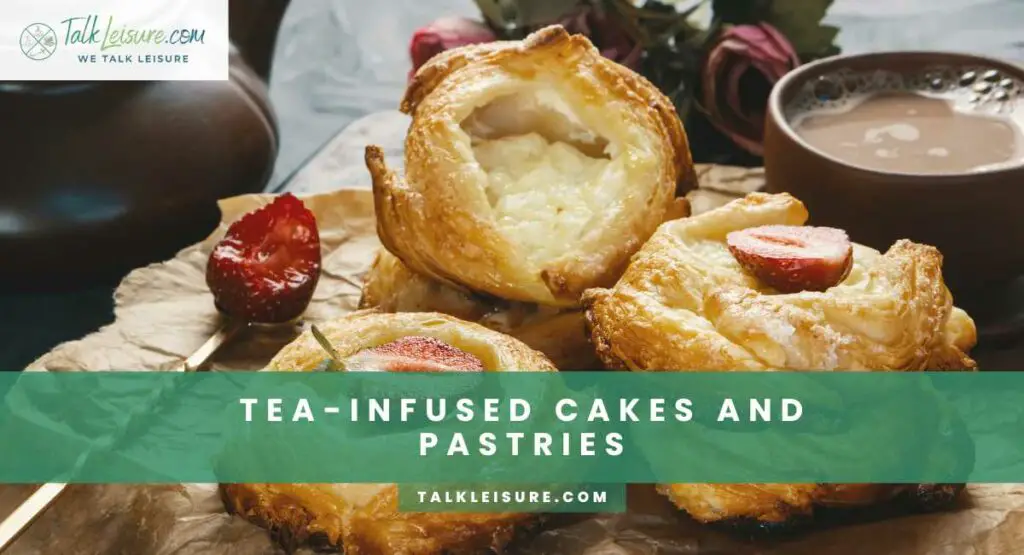
Get ready to experience the aromatic world of tea-infused cakes and pastries. These recipes promise a symphony of flavors, where the comforting warmth of tea meets the decadence of cakes and layers of delicate pastry.
Chai Spiced Cake: Aromatic and Rich
This Chai Spiced Cake is a sensory journey through the aromatic spices of India combined with the comforting notes of black tea. Moist and fragrant, it’s a cake that captures the essence of a cozy afternoon tea.
Ingredients:
- Flour
- Chai tea blend
- Butter
- Sugar
- Eggs
- Baking powder
- Milk
Instructions:
- Infuse chai tea blend in hot milk, then strain and cool.
- Cream butter, sugar, and eggs, then fold in the flour and baking powder.
- Add the chai-infused milk and mix until smooth.
- Bake until golden, and savor the irresistible aroma.
Green Tea Mille-Feuille: Layers of Elegance
Elevate your pastry game with this Green Tea Mille-Feuille. Delicate layers of puff pastry encase a velvety green tea custard, creating a dessert that’s as visually stunning as it is delicious.
Ingredients:
- Puff pastry sheets
- Green tea powder
- Milk
- Egg yolks
- Sugar
- Cornstarch
Instructions:
- Bake puff pastry sheets until golden and crisp.
- Infuse milk with green tea powder, then mix with egg yolks, sugar, and cornstarch.
- Cook until thickened, then let it cool.
- Assemble the mille-feuille with alternating layers of pastry and green tea custard.
Tea-Infused Ice Creams and Sorbets
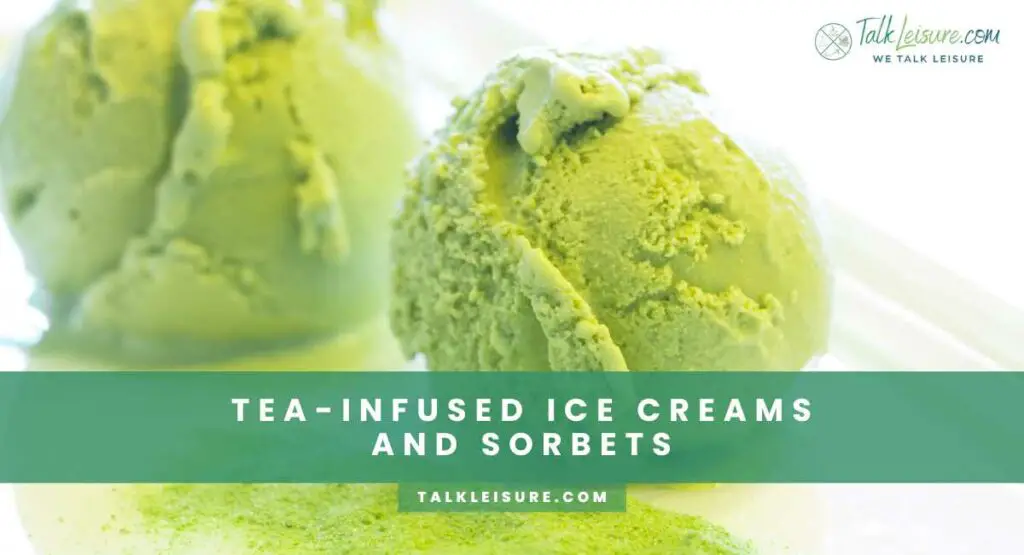
Cool down with the refreshing allure of tea-infused ice creams and sorbets. These frozen delights bring together the soothing qualities of tea with the lusciousness of creamy ice cream and the vibrancy of sorbets.
Jasmine Tea Ice Cream: Fragrant and Refreshing
Indulge in the delicate aroma of jasmine flowers in this Jasmine Tea Ice Cream. The fragrance alone is enough to transport you to a serene garden. With each spoonful, you’ll experience a balance of creaminess and floral notes that is simply enchanting.
Ingredients:
- Heavy cream
- Jasmine tea leaves
- Sugar
- Egg yolks
- Milk
Instructions:
- Infuse jasmine tea leaves in warm cream to extract the fragrance.
- Whisk egg yolks and sugar until creamy.
- Combine the infused cream with the egg mixture, then heat until thickened.
- Cool, then churn in an ice cream maker until creamy and frozen.
Rooibos Berry Sorbet: A Vibrant Palette of Flavors
Experience a burst of color and flavor with this Rooibos Berry Sorbet. The earthy richness of rooibos tea complements the bright, tangy notes of mixed berries. It’s a sorbet that’s as visually appealing as it is delicious.
Ingredients:
- Rooibos tea leaves
- Mixed berries (strawberries, blueberries, raspberries)
- Sugar
- Water
Instructions:
- Brew rooibos tea and let it cool.
- Blend the mixed berries with sugar and water until smooth.
- Strain the berry mixture to remove seeds, then combine with the brewed rooibos tea.
- Freeze the mixture in an ice cream maker until smooth and sorbet-like.
Tea-Infused Cookies and Biscuits
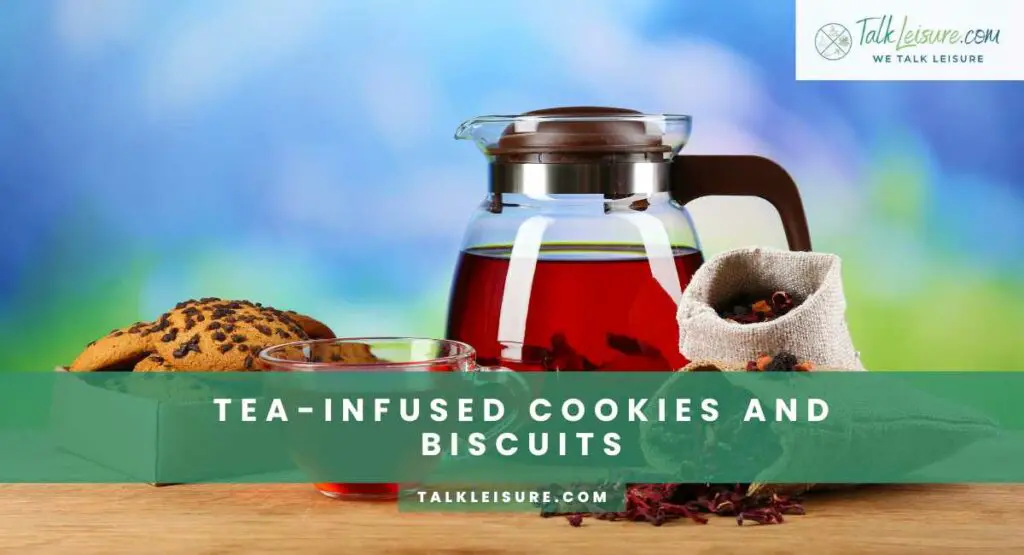
Delight in the subtle infusion of tea in these delectable cookies and biscuits. From the calming embrace of lavender chamomile to the nuanced complexity of oolong, these treats offer a unique twist on traditional favorites.
Lavender Chamomile Shortbread: Delicate and Calming
Relax and unwind with the delicate flavors of Lavender Chamomile Shortbread. These buttery, crumbly cookies are infused with the soothing scents of lavender and chamomile, making them the perfect companion for a moment of tranquility.
Ingredients:
- Flour
- Dried lavender buds
- Dried chamomile flowers
- Butter
- Sugar
Instructions:
- Grind dried lavender and chamomile to a fine powder.
- Cream butter, sugar, and the herbal mixture until light and fluffy.
- Gradually add flour until a dough forms.
- Shape, chill, and slice before baking to golden perfection.
Oolong Tea Butter Cookies: A Subtle Complexity
Experience a symphony of flavors with these Oolong Tea Butter Cookies. The subtle, nutty notes of oolong tea meld seamlessly with the buttery richness of these cookies, offering a taste that’s both comforting and delightfully complex.
Ingredients:
- Oolong tea leaves
- Flour
- Butter
- Sugar
- Egg yolk
Instructions:
- Grind oolong tea leaves into a fine powder.
- Cream butter, sugar, and oolong tea until well combined.
- Gradually add flour until a dough forms.
- Shape into cookies, then bake until lightly golden around the edges.
These tea-infused desserts and pastries promise a culinary adventure like no other. With a blend of fragrant teas and decadent treats, each recipe invites you to savor the art of infusion.
So, don your apron, brew your favorite tea, and let the magic begin!
Tea-Infused Beverages to Complement Desserts

The perfect beverage can enhance the experience of enjoying tea-infused desserts. In this section, we’ll explore how to pair teas with sweets for a harmonious balance, and even take it a step further with tea-based cocktails and mocktails to elevate your culinary adventure.
Pairing Teas with Sweets: A Harmonious Balance
Finding the right tea to complement your dessert is akin to discovering a musical harmony. The goal is to create a seamless fusion of flavors that delight the palate. Here, we’ll delve into some classic pairings that have stood the test of time.
Classic Pairings:
- Black Tea with Chocolate: The robustness of black tea stands up well to the rich, deep flavors of chocolate. Whether it’s a dense chocolate cake or silky truffles, a cup of black tea on the side enhances the experience.
- Green Tea with Fruit Desserts: The bright, fruity notes of green tea harmonize beautifully with desserts featuring berries, citrus, or tropical fruits. It offers a refreshing contrast to the sweetness.
- Herbal Infusions with Light, Citrusy Desserts: Delicate herbal infusions like chamomile or lemon verbena complement desserts with a light, citrusy profile. Think lemon tarts or delicate fruit salads.
Creating Your Pairing:
- Intensity Matching: Consider the intensity of both the dessert and the tea. A bold dessert can stand up to a strong tea, while delicate pastries may benefit from a milder brew.
- Contrast or Complement: Decide whether you want the tea to contrast or complement the dessert. For example, a tart lemon dessert can be complemented by a slightly sweet, floral tea.
- Temperature Considerations: Hot tea can be a comforting contrast to cold desserts, while iced tea can refresh the palate after a warm treat.
Remember, there are no strict rules here—personal preference is key. Feel free to experiment and discover your own perfect pairings.
Tea Cocktails and Mocktails: Elevating the Experience
Taking tea to the next level, we explore the world of tea-based cocktails and mocktails. These beverages not only complement desserts but also add an extra layer of sophistication to your culinary experience.
Tea Cocktails:
- Earl Grey Martini: Infuse gin with Earl Grey tea for a sophisticated, aromatic martini. Garnish with a twist of lemon.
- Matcha Mojito: Combine matcha with fresh mint, lime, and rum for a vibrant, invigorating cocktail.
Tea Mocktails:
- Hibiscus Sparkler: Brew hibiscus tea, chill, and top with sparkling water for a refreshing, tangy mocktail.
- Chai Apple Cider Punch: Warm chai spices infused in apple cider create a comforting, alcohol-free punch.
Tips for Success:
- Balanced Flavors: Ensure the tea’s flavor complements the other ingredients in your cocktail or mocktail.
- Proper Brewing: Pay attention to the brewing process; oversteeping can lead to bitter flavors.
- Garnishes and Presentation: Elevate your drink with thoughtful garnishes, like citrus twists, fresh herbs, or edible flowers.
With these tea-based beverages, you’re not only adding a unique twist to your dessert experience but also inviting a whole new level of culinary creativity to the table.
With these beverage pairings, your tea-infused desserts will be elevated to a whole new level.
Whether you’re sipping a carefully chosen tea alongside your sweets or indulging in a tea-based cocktail, your taste buds are in for a treat. So, let’s raise a cup to the art of tea infusion!
Health Benefits of Tea-Infused Desserts
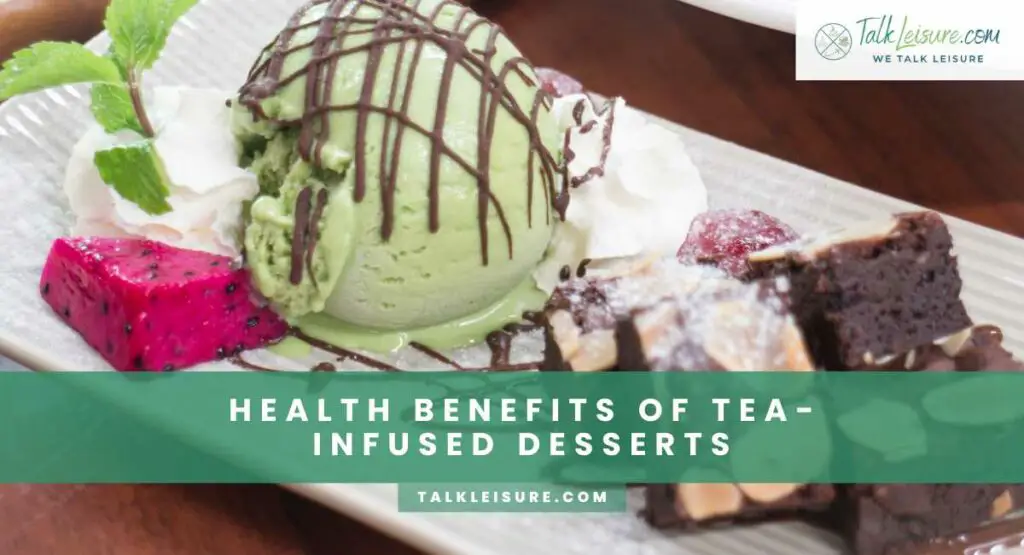
Tea-infused desserts aren’t just a delight for the taste buds—they also bring a host of health benefits to the table. In this section, we’ll explore how these treats offer more than just a sweet indulgence.
Antioxidant Properties of Tea-Infused Treats
Tea is renowned for its high antioxidant content, and when infused into desserts, these benefits are passed on. Antioxidants help combat free radicals in the body, which can contribute to aging and various diseases.
By incorporating tea into your desserts, you’re not only treating your palate but also providing your body with a powerful dose of antioxidants.
Additional Health Benefits:
- Supports heart health
- Aids in digestion
- Boosts metabolism and weight management
Indulgence with a Nutritional Boost
Tea-infused desserts offer a unique opportunity to indulge in sweets without compromising on nutrition. Depending on the type of tea used, desserts can provide vitamins, minerals, and other beneficial compounds. For instance, matcha-infused treats are rich in chlorophyll, amino acids, and fiber, making them a nutritious addition to your diet.
Specific Nutritional Benefits:
- Enhanced mental alertness and focus (with matcha)
- Improved digestion and gut health (with herbal infusions)
- Increased metabolism and energy levels (with green tea)
Tips for Mastering Tea-Infused Desserts at Home
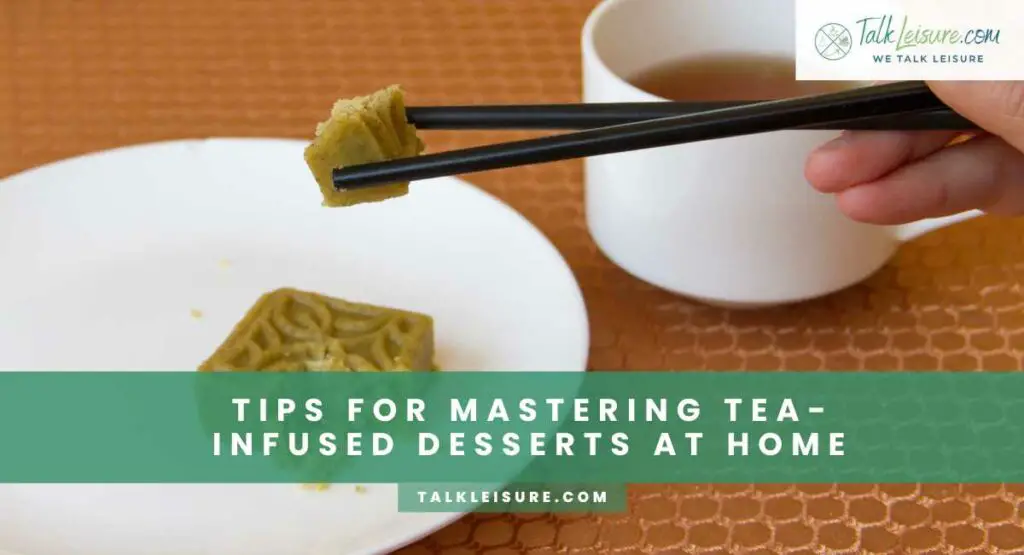
Mastering the art of tea-infused desserts takes a blend of technique, creativity, and a touch of intuition. In this section, we’ll delve into essential tips that will set you on the path to becoming a tea-infusion maestro in your own kitchen.
Balancing Flavors: The Key to Success
Achieving the perfect balance of tea flavor in your desserts is crucial. Too subtle, and it may get lost amidst other ingredients; too overpowering, and it might dominate the entire dish. Finding this equilibrium is the secret to creating tea-infused desserts that are truly exceptional.
Tips for Balancing Flavors:
- Start with a small amount of tea and gradually increase if needed.
- Consider the intensity of the tea and the other flavors in your recipe.
- Taste as you go and trust your palate to guide you.
Experimenting with Your Own Infusions
While classic teas are excellent choices for infusion, don’t be afraid to venture into uncharted territory. Experimenting with custom tea blends and infusions can lead to truly unique and unforgettable flavor combinations. The world of tea is vast, and there are endless possibilities waiting to be discovered.
Steps for Successful Experimentation:
- Start with a base tea and explore complementary herbs, spices, or botanicals.
- Keep detailed notes on the ratios and combinations you try.
- Embrace the process of trial and error; some of the most extraordinary infusions arise from unexpected pairings.
Presentation and Serving Suggestions
The visual appeal and thoughtful presentation of tea-infused desserts add an extra layer of delight to the culinary experience. In this section, we’ll explore techniques for beautifully presenting your creations, as well as offer recommendations for pairing teas to enhance overall enjoyment.
Plating Techniques for Tea-Infused Creations
Elevate the visual appeal of your tea-infused desserts with strategic plating techniques. The presentation of your creations is an art form in itself, and it can greatly enhance the overall dining experience. Here are some tips to consider:
- Balance and Composition: Consider the placement of each element on the plate. Create balance by distributing components evenly and with purpose.
- Color Harmony: Use a color palette that complements the hues of your dessert. For example, pair green tea desserts with vibrant fruits for a visually appealing contrast.
- Texture Variation: Incorporate different textures, such as crunchy elements or creamy sauces, to add depth and interest to the plate.
- Garnish with Care: Thoughtful garnishes, like edible flowers, citrus zest, or a sprinkle of tea leaves, can add a finishing touch that ties the presentation together.
Tea Pairing Recommendations for Optimal Enjoyment
Pairing the right tea with your dessert can elevate both the flavor of the tea and the overall enjoyment of the dessert. Consider these recommendations for an enhanced culinary experience:
- Chai Tea with Spiced Desserts: The warm, aromatic spices in chai tea complement desserts like apple pie or gingerbread cookies.
- Oolong Tea with Creamy Desserts: The subtle complexity of oolong tea pairs beautifully with creamy or custard-based desserts like crème brûlée.
- Herbal Infusions with Light Desserts: Delicate herbal infusions, such as chamomile or mint, complement light, citrusy desserts like lemon tarts.
- Earl Grey with Citrus-Flavored Desserts: The bergamot in Earl Grey tea harmonizes with citrus flavors, making it an excellent match for lemon or orange-infused desserts.
Popular Tea-Infused Dessert Recipes from Around the World
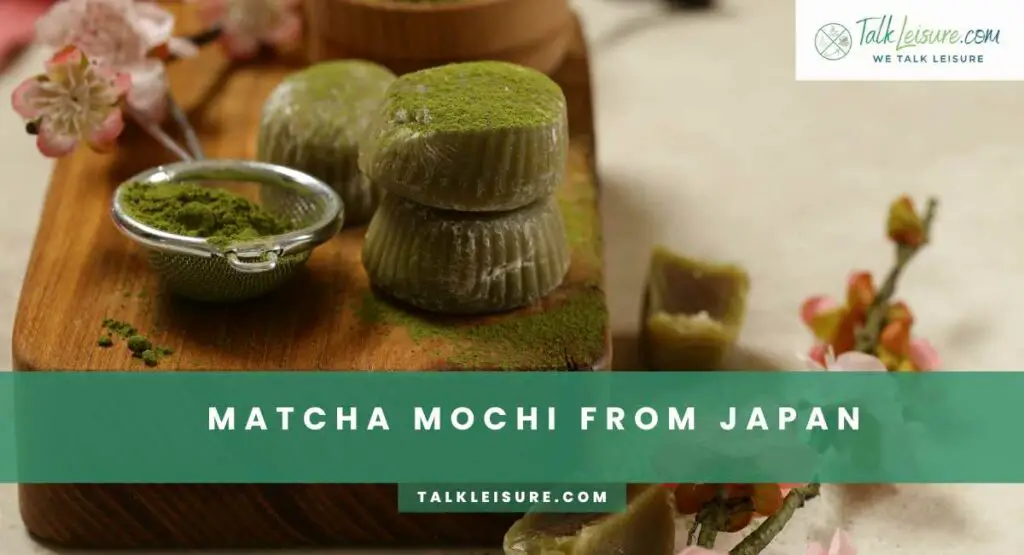
Embark on a global culinary journey as we explore tea-infused dessert recipes from various traditions and regions. These recipes offer a glimpse into the rich tapestry of global tea-infused culinary traditions, as well as introduce unique variations you may not have tried before.
Insights into Global Tea-Infused Culinary Traditions
Dive into the diverse world of tea-infused desserts with a tour of global culinary traditions. From the matcha-infused confections of Japan to the aromatic chai-spiced sweets of India, each culture brings its own unique flair to the art of tea-infused treats.
Highlights:
- Matcha Mochi from Japan: Soft, chewy mochi infused with vibrant matcha powder.
- Chai-Spiced Gulab Jamun from India: Soft, syrup-soaked milk solids infused with aromatic chai spices.
Unique Variations You Might Not Have Tried
Expand your tea-infused dessert repertoire with these innovative and lesser-known variations. These recipes offer a fresh perspective on the marriage of tea and sweets, introducing unexpected flavors and textures that are sure to captivate your taste buds.
Explorations:
- Genmaicha Rice Krispie Treats: Crispy rice cereal bars infused with the nutty, toasty flavors of genmaicha tea.
- Lavender Rooibos Infused Honey Cake: A fragrant honey cake, elevated with the soothing notes of lavender and rooibos.
With these presentation tips, tea pairings, and an exploration of global tea-infused desserts, you’re equipped to take your culinary journey to new heights.
Whether you’re savoring a delicately plated creation or experimenting with a unique twist on a classic, the world of tea-infused desserts is yours to explore and savor.
Conclusion
In this exploration of tea-infused desserts, we’ve uncovered a world of culinary alchemy. The delicate dance between tea and sweets has yielded creations that tantalize the senses and offer a depth of flavor beyond the ordinary.
From the antioxidant-rich benefits to the sheer pleasure of taste, these desserts are a testament to the endless possibilities that arise when tradition meets innovation.
Whether you’re savoring a classic Earl Grey Crème Brûlée or experimenting with your own unique infusions, this journey celebrates the art of infusion in all its delicious forms.
May you continue to infuse your culinary creations with the magic of tea, creating moments of pure delight for yourself and those you share them with. Cheers to the delightful world of tea-infused indulgence!
Frequently Asked Questions
- What are called pastries?
Pastries are a category of baked goods that are typically made from dough, often enriched with butter or other fats, and then rolled, folded, and shaped into various forms.
They can range from sweet to savory and are often characterized by their flaky, tender, and sometimes crispy texture. Common examples of pastries include croissants, puff pastry,
Danish pastries, tarts, and pies. Sweet pastries may be filled with fruits, creams, or other sweet fillings, while savory pastries can contain ingredients like meats, cheeses, and vegetables. Pastries are popular in many cuisines around the world and are enjoyed for their delicious and versatile nature.
- How are tea cakes served?
Tea cakes are typically served in a manner that complements their delicate, slightly sweet flavor. Here are some common ways tea cakes are served:
- Plain or with Butter: Tea cakes can be served simply, either on their own or with a small pat of butter. This allows the natural flavor of the cake to shine through.
- Accompanied by Tea or Coffee: As the name suggests, tea cakes pair beautifully with a cup of tea. They also go well with coffee, providing a nice contrast to the beverage’s bitterness.
- With Clotted Cream and Jam: This is a classic British way to serve tea cakes, particularly with fruit scones. The creaminess of clotted cream and the sweetness of jam complement the cake’s texture and flavor.
- Dusted with Powdered Sugar: A light dusting of powdered sugar adds a touch of sweetness and elegance to the presentation of a tea cake.
- Fruit Toppings or Compotes: Serving tea cakes with fresh fruit toppings or fruit compotes adds a burst of color, flavor, and juiciness to each bite.
- Whipped Cream or Cream Cheese Frosting: For a more indulgent treat, tea cakes can be served with a dollop of whipped cream or a schmear of cream cheese frosting.
- Accompanied by Nuts: Chopped nuts, like almonds or walnuts, can add a delightful crunch to the soft texture of a tea cake.
- Warm with Custard or Ice Cream: Serving a warm tea cake with a scoop of vanilla ice cream or a drizzle of custard creates a comforting, satisfying dessert.
Remember, the best way to serve a tea cake ultimately depends on personal preference and the occasion. Whether simple or adorned, tea cakes are a delightful treat that can be enjoyed in a variety of ways.
- What are 3 examples of pastries?
Here are three examples of pastries:
- Croissant: A classic French pastry made from layers of buttery, flaky dough. Croissants are known for their crescent shape and delightful, buttery flavor. They can be enjoyed plain or filled with various sweet or savory fillings like chocolate, almond paste, or ham and cheese.
- Danish Pastry: Originating from Denmark, these pastries are made from a yeast-leavened dough that’s rolled out and folded several times to create layers. They can be shaped into various forms, including twists, braids, or pinwheels. Danish pastries are often filled with fruit, cream cheese, almond paste, or nuts, and they’re topped with icing or streusel.
- Éclair: A French pastry made from choux pastry dough, which is piped into an elongated shape and baked until crisp and hollow inside. Éclairs are typically filled with cream, custard, or whipped cream and then topped with a glossy icing, often chocolate. They are known for their decadent and indulgent taste.
These pastries are beloved around the world for their delicious, flaky, and sometimes creamy textures, making them a delightful treat for breakfast, brunch, or dessert.







